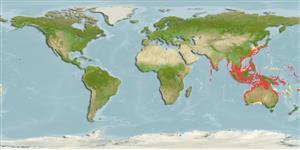Common names from other countries
Environment: milieu / climate zone / depth range / distribution range
Ecología
; salobre; rango de profundidad 8 - 95 m (Ref. 8), usually 20 - 60 m (Ref. 409). Tropical; 36°N - 35°S, 72°E - 165°W
Indo-West Pacific.
Length at first maturity / Tamaño / Peso / Age
Maturity: Lm ?, range 4 - ? cm Max length : 15.4 cm BL macho / no sexado; (Ref. 409); 18.9 cm BL (female); peso máximo publicado: 18.00 g (Ref. 116487)
Maximum carapace length: 3.5 cm (male); 4.2 cm (female) (Ref. 8). Common body length: 7.0 to 14.0 cm (Ref. 409). Minimum depth range from Ref. 111048. Subtidal (Ref. 106854). Found mainly in turbid waters down to a depth of 95 m over bottoms of mud, sandy-mud or silt. Juveniles are found in estuaries and backwaters, also in seagrass beds, mangrove banks, mud flats, and open channels (Ref. 8) while adults are found in deeper waters (Ref. 10). Juveniles from a riverine mangrove are likely to obtain nutrition from phytoplankton and possibly epiphytic algae than from mangrove leaves or detritus (Ref. 105141). Omnivore (Ref. 116259).
Life cycle and mating behavior
Madurez | Reproducción | Puesta | Huevos | Fecundidad | Larva
Members of the order Decapoda are mostly gonochoric. Mating behavior: Precopulatory courtship ritual is common (through olfactory and tactile cues); usually indirect sperm transfer.
Holthuis, L.B. 1980. (Ref. 8)
IUCN Red List Status (Ref. 130435)
CITES status (Ref. 108899)
Not Evaluated
Not Evaluated
Human uses
Pesquerías: muy comercial; carnada: occasionally
FAO - Acuicultura: producción; | FishSource | Sea Around Us
Herramientas
Fuentes de Internet
Estimates based on models
Preferred temperature
(Ref.
115969): 24.2 - 29.1, mean 28.1 (based on 1590 cells).
Resiliencia
Alto, población duplicada en un tiempo mínimo inferior a 15 meses (K=1.49-1.52).
Vulnerability
Low vulnerability (10 of 100).
